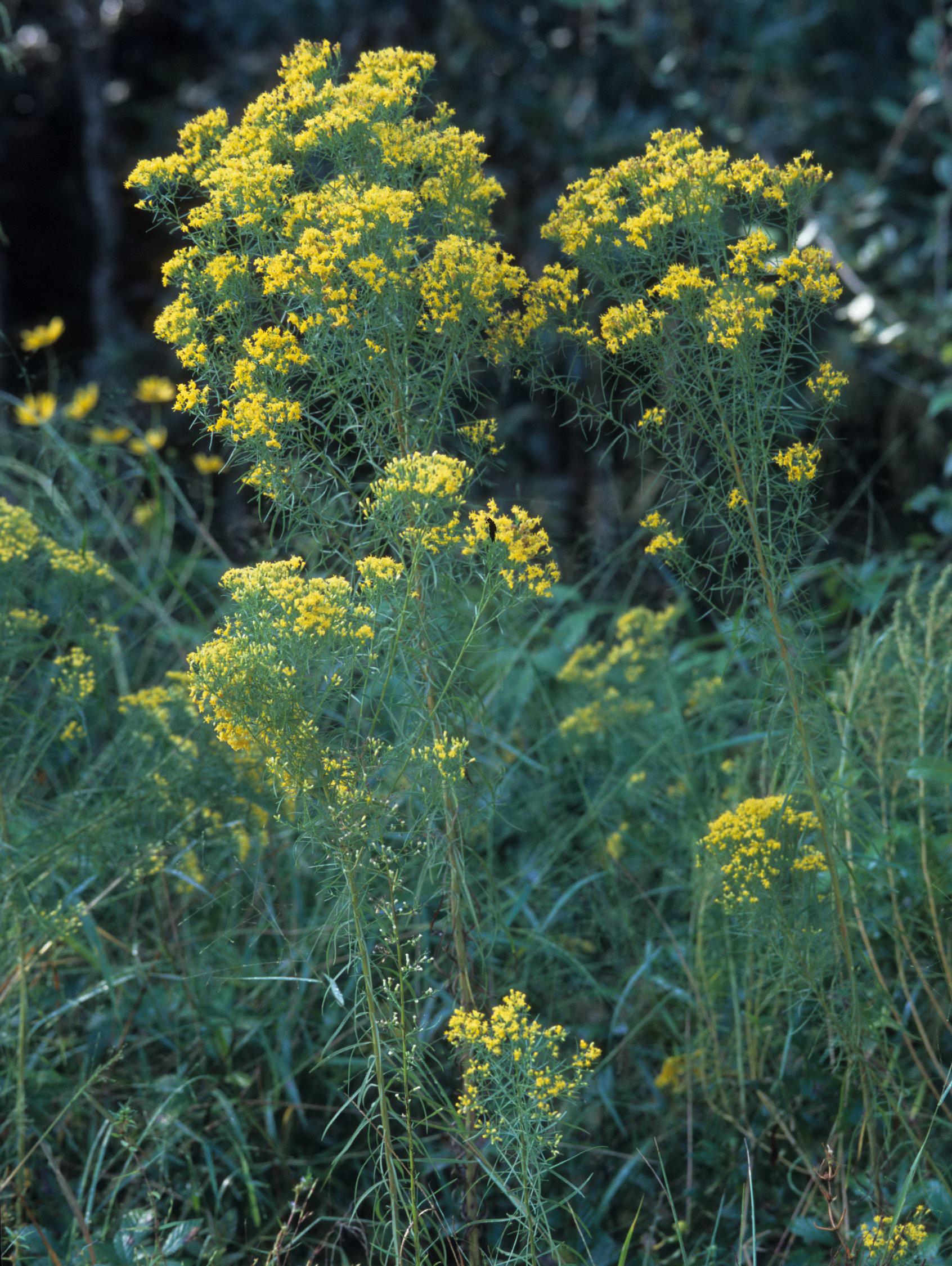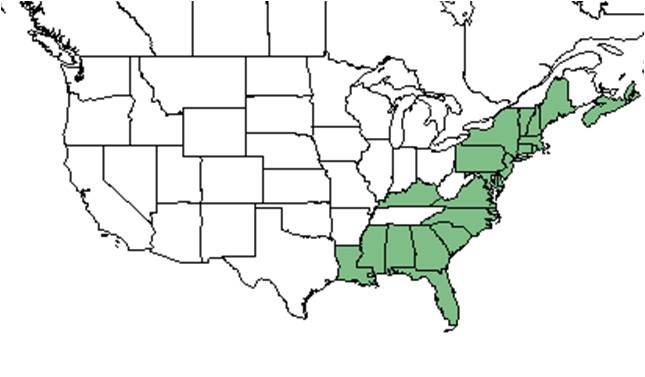Difference between revisions of "Euthamia caroliniana"
(→Ecology) |
|||
| Line 51: | Line 51: | ||
It has been observed to commonly grow in habitats that are frequently burned and annually burned.<ref name= "herbarium"/> The seeds of this plant were also seen to persist in the seed bank even after a fire disturbance.<ref name= "Kalmbacher"/> | It has been observed to commonly grow in habitats that are frequently burned and annually burned.<ref name= "herbarium"/> The seeds of this plant were also seen to persist in the seed bank even after a fire disturbance.<ref name= "Kalmbacher"/> | ||
| − | ===Pollination=== | + | ===Pollination and use by animals=== |
| − | + | ''Euthamia caroliniana'' has been observed at the Archbold Biological Station to host a variety of species, such as ''Andrena fulvipennis'' (family Andrenidae), members of the family Apidae such as ''Apis mellifera, Bombus impatiens,'' and ''Epeolus carolinus'', members of the family Colletidae such as ''Colletes mandibularis, C. simulans, C. thysanellae,'' and ''Hylaeus confluens'', members of the family Halictidae such as ''Agapostemon splendens, Augochlorella aurata, Halictus poeyi, Lasioglossum nymphalis, L. placidensis, L. puteulanum,'' and ''Sphecodes heraclei'', members of the family Leucospidae such as ''Leucospis affinis, L. affinis, L. robertsoni,'' and ''L. slossonae'', members of the family Megachilidae such as ''Anthidiellum perplexum, Coelioxys dolichos, C. octodentata, C. sayi, Megachile albitarsis,'' and ''M. mendica'', members of the family Pompilidae such as ''Anoplius atrox, A. marginalis,'' and ''Paracyphonyx funereus'', members of the family Sphecidae such as ''Ammophila pictipennis, Anacrabro ocellatus, Bembix sayi, Cerceris blakei, Ectemnius rufipes ais, Epinysson mellipes, Isodontia exornata, Liris beata, Microbembex monodonta, Palmodes dimidiatus, Philanthus politus, P. ventilabris, Prionyx thomae, Tachysphex similis,'' and ''Tachytes validus'', as well as members of the family Vespidae ''Euodynerus boscii boharti, E. hidalgo, Pachodynerus erynnis, Parancistrocerus salcularis rufulus, Polistes bellicosus, P. carolina, P. dorsalis hunteri, P. fuscatus, P. perplexus, Zethus slossonae,'' and ''Z. spinipes''.<ref name=dey> Deyrup, M.A. and N.D. 2015. Database of observations of Hymenoptera visitations to flowers of plants on Archbold Biological Station, Florida, USA.</ref> Other members of the Hymenoptera order observed to pollinate ''E. caroliniana'' include ''Dialictus nymphalis'', ''D. placidensis'', ''D. tegulairs'', ''Halictus ligatus'', ''Tripeolus georgicus'', and ''Xylocopa micans''.<ref>Deyrup, M. J. E., and Beth Norden (2002). "The diversity and floral hosts of bees at the Archbold Biological Station, Florida (Hymenoptera: Apoidea)." Insecta mundi 16(1-3).</ref><ref>Hall, H. G. a. J. S. A. (2010). "Surveys of bees (Hymenoptera: Apoidea: Anthophila) in natural areas of Alachua County in north-central Florida." The Florida Entomologist 93(4): 609-629.</ref> Additionally, this species has been observed to host members of the family Andrenidae such as ''Andrena braccata'', and ''Andrena hirticincta'', members of the family Apidae such as ''Bombus griseocollis'' and ''Melissodes druriella'', members of the family Colletidae such as ''Colletes americanus'' and ''Colletes speculiferus'', as well as members of the family Halictidae such as ''Halictus rubicundus'' and ''Lasioglossum zephyrum''.<ref>Discoverlife.org [https://www.discoverlife.org/20/q?search=Bidens+albaDiscoverlife.org|Discoverlife.org]</ref> Overall, this species is recognized by pollination ecologists to be of special value for native bees since it attracts large numbers of native bees for pollination.<ref name= "lady bird"/> ''E. caroliniana'' consists of approximately 2-5% of the diet for large mammals, small mammlas, and various terrestrial birds.<ref>Miller, J.H., and K.V. Miller. 1999. Forest plants of the southeast and their wildlife uses. Southern Weed Science Society.</ref> | |
| − | |||
| − | |||
| − | |||
| − | Apidae | ||
| − | |||
| − | Colletidae | ||
| − | |||
| − | Halictidae | ||
| − | |||
| − | Leucospidae | ||
| − | |||
| − | Megachilidae | ||
| − | |||
| − | Pompilidae | ||
| − | |||
| − | Sphecidae | ||
| − | |||
| − | Vespidae | ||
| − | |||
| − | Other members of the Hymenoptera order observed to pollinate ''E. caroliniana'' include ''Dialictus nymphalis'', ''D. placidensis'', ''D. tegulairs'', ''Halictus ligatus'', ''Tripeolus georgicus'', and ''Xylocopa micans''.<ref>Deyrup, M. J. E., and Beth Norden (2002). "The diversity and floral hosts of bees at the Archbold Biological Station, Florida (Hymenoptera: Apoidea)." Insecta mundi 16(1-3).</ref><ref>Hall, H. G. a. J. S. A. (2010). "Surveys of bees (Hymenoptera: Apoidea: Anthophila) in natural areas of Alachua County in north-central Florida." The Florida Entomologist 93(4): 609-629.</ref> Overall, this species is recognized by pollination ecologists to be of special value for native bees since it attracts large numbers of native bees for pollination.<ref name= "lady bird"/> | ||
| − | |||
| − | |||
| − | |||
<!--===Diseases and parasites===--> | <!--===Diseases and parasites===--> | ||
Revision as of 12:57, 14 June 2021
| Euthamia caroliniana | |
|---|---|

| |
| Photo taken by Gil Nelson | |
| Scientific classification | |
| Kingdom: | Plantae |
| Division: | Magnoliophyta - Flowering plants |
| Class: | Magnoliopsida - Dicotyledons |
| Order: | Asterales |
| Family: | Asteraceae ⁄ Compositae |
| Genus: | Euthamia |
| Species: | E. caroliniana |
| Binomial name | |
| Euthamia caroliniana (L.) Greene ex Porter & Britton | |

| |
| Natural range of Euthamia caroliniana from USDA NRCS Plants Database. | |
Common names: Slender goldentop; Slender flattop goldenrod; Coastal Plain goldentop
Contents
Taxonomic notes
Synonyms: Solidago microcephala (Nuttall) Bush; S. tenuifolia Pursh; S. tenuifolia var. tenuifolia Pursh; Euthamia minor (Michaux) Greene; E. tenuifolia (Pursh) Nuttall; E. tenuifolia var. microcephala Nuttall; E. tenuifolia var. (Pursh) Nuttall tenuifolia.[1]
Varieties: none.[1]
Description
A description of Euthamia caroliniana is provided in The Flora of North America. Overall, it has grass-like leaves that contain tiny resin dots as well as only one vein or rib.[2] It grows up to a meter tall from a branched and creeping rhizome. Inflorescence contains 10 to 20 flowers.[3]
Distribution
E. caroliniana is distributed from southern Maine south to southern Florida and west to southeastern Louisiana, and mainly along the southeast coastal plain. However, its distribution does extend into the Piedmont in some areas.[4] It is also native to the Nova Scotia province in Canada.[5]
Ecology
Habitat
Generally, E. caroliniana is found in moist forests, pine savannas, pastures, ditches, and other disturbed areas.[4] It has been observed in a range of habitats including roadsides, pine flatwoods, barren sandhills, poorly drained areas, boggy margins, exposed sand in sparse woods, and other disturbed areas like roadside ditches. Soils observed are dry sand and various sandy loam.[6]
Associated species include Liatris laevigata, Liatris gracilis, Polygonella polygama, Polygonella gracilis, Diodia teres, Diodia virginiana, Croptilion sp., Sisyrinchium sp., Dalea sp., Solidago sp., Acalypha gracilens, Chrysopsis lanuginosa, Rubus cuneifolius, Hypericum gentianoides, Trichostema dichotomum, Eupatorium compositifolium, and others.[6]
Phenology
It generally flowers from September to December as well as sometimes in August.[4] E. caroliniana has been observed to flower in September and October.[7]
Seed dispersal
This species is thought to be dispersed by wind. [8]
Seed bank and germination
Forms a persistent soil seed bank.[9] One study also found the seeds of E. caroliniana to persist in the seed bank after a fire disturbance.[10]
Fire ecology
It has been observed to commonly grow in habitats that are frequently burned and annually burned.[6] The seeds of this plant were also seen to persist in the seed bank even after a fire disturbance.[10]
Pollination and use by animals
Euthamia caroliniana has been observed at the Archbold Biological Station to host a variety of species, such as Andrena fulvipennis (family Andrenidae), members of the family Apidae such as Apis mellifera, Bombus impatiens, and Epeolus carolinus, members of the family Colletidae such as Colletes mandibularis, C. simulans, C. thysanellae, and Hylaeus confluens, members of the family Halictidae such as Agapostemon splendens, Augochlorella aurata, Halictus poeyi, Lasioglossum nymphalis, L. placidensis, L. puteulanum, and Sphecodes heraclei, members of the family Leucospidae such as Leucospis affinis, L. affinis, L. robertsoni, and L. slossonae, members of the family Megachilidae such as Anthidiellum perplexum, Coelioxys dolichos, C. octodentata, C. sayi, Megachile albitarsis, and M. mendica, members of the family Pompilidae such as Anoplius atrox, A. marginalis, and Paracyphonyx funereus, members of the family Sphecidae such as Ammophila pictipennis, Anacrabro ocellatus, Bembix sayi, Cerceris blakei, Ectemnius rufipes ais, Epinysson mellipes, Isodontia exornata, Liris beata, Microbembex monodonta, Palmodes dimidiatus, Philanthus politus, P. ventilabris, Prionyx thomae, Tachysphex similis, and Tachytes validus, as well as members of the family Vespidae Euodynerus boscii boharti, E. hidalgo, Pachodynerus erynnis, Parancistrocerus salcularis rufulus, Polistes bellicosus, P. carolina, P. dorsalis hunteri, P. fuscatus, P. perplexus, Zethus slossonae, and Z. spinipes.[11] Other members of the Hymenoptera order observed to pollinate E. caroliniana include Dialictus nymphalis, D. placidensis, D. tegulairs, Halictus ligatus, Tripeolus georgicus, and Xylocopa micans.[12][13] Additionally, this species has been observed to host members of the family Andrenidae such as Andrena braccata, and Andrena hirticincta, members of the family Apidae such as Bombus griseocollis and Melissodes druriella, members of the family Colletidae such as Colletes americanus and Colletes speculiferus, as well as members of the family Halictidae such as Halictus rubicundus and Lasioglossum zephyrum.[14] Overall, this species is recognized by pollination ecologists to be of special value for native bees since it attracts large numbers of native bees for pollination.[2] E. caroliniana consists of approximately 2-5% of the diet for large mammals, small mammlas, and various terrestrial birds.[15]
Conservation, cultivation, and restoration
This species is listed as threatened by the Maine Department of Conservation, Natural Areas Program, and by the Pennsylvania Department of Conservation and Natural Resources.[5]
Cultural use
Photo Gallery
References and notes
- ↑ 1.0 1.1 Weakley, A.S. 2015. Flora of the southern and mid-atlantic states. Working Draft of 21 May 2015. University of North Carolina at Chapel Hill, Chapel Hill, North Carolina.
- ↑ 2.0 2.1 [[1]] Lady Bird Johnson Wildflower Center. Accessed: May 13, 2019
- ↑ [[2]] NatureServe Explorer. Accessed: May 13, 2019
- ↑ 4.0 4.1 4.2 Weakley, A. S. (2015). Flora of the Southern and Mid-Atlantic States. Chapel Hill, NC, University of North Carolina Herbarium.
- ↑ 5.0 5.1 USDA, NRCS. (2016). The PLANTS Database (http://plants.usda.gov, 13 May 2019). National Plant Data Team, Greensboro, NC 27401-4901 USA.
- ↑ 6.0 6.1 6.2 Florida State University Robert K. Godfrey Herbarium database. URL: http://herbarium.bio.fsu.edu. Last accessed: May 2019. Collectors: Loran C. Anderson, Wilson Baker, - Boothes, Andre F. Clewell, Angus Gholson, Robert K. Godfrey, Faith Jackson, R. Komarek, T. MacClendon, Leon Neel, and R. A. Norris. States and Counties: Florida: Calhoun, Franklin, Gadsden, Gulf, Jackson, Lafayette, Leon, Liberty, Nassau, Wakulla, and Washington. Georgia: Baker, Grady, and Thomas. South Carolina: Richland.
- ↑ Nelson, G. PanFlora: Plant data for the eastern United States with emphasis on the Southeastern Coastal Plains, Florida, and the Florida Panhandle. www.gilnelson.com/PanFlora/ Accessed: 9 DEC 2016
- ↑ Kirkman, L. Katherine. Unpublished database of seed dispersal mode of plants found in Coastal Plain longleaf pine-grasslands of the Jones Ecological Research Center, Georgia.
- ↑ Navarra, J. J., N. Kohfeldt, et al. (2011). "Seed bank changes with time since fire in Florida rosemary scrub." Fire Ecology 7(2).
- ↑ 10.0 10.1 Kalmbacher, R., et al. (2005). "Seeds obtained by vacuuming the soil surface after fire compared with soil seedbank in a flatwoods plant community." Native Plants Journal 6: 233-241.
- ↑ Deyrup, M.A. and N.D. 2015. Database of observations of Hymenoptera visitations to flowers of plants on Archbold Biological Station, Florida, USA.
- ↑ Deyrup, M. J. E., and Beth Norden (2002). "The diversity and floral hosts of bees at the Archbold Biological Station, Florida (Hymenoptera: Apoidea)." Insecta mundi 16(1-3).
- ↑ Hall, H. G. a. J. S. A. (2010). "Surveys of bees (Hymenoptera: Apoidea: Anthophila) in natural areas of Alachua County in north-central Florida." The Florida Entomologist 93(4): 609-629.
- ↑ Discoverlife.org [3]
- ↑ Miller, J.H., and K.V. Miller. 1999. Forest plants of the southeast and their wildlife uses. Southern Weed Science Society.